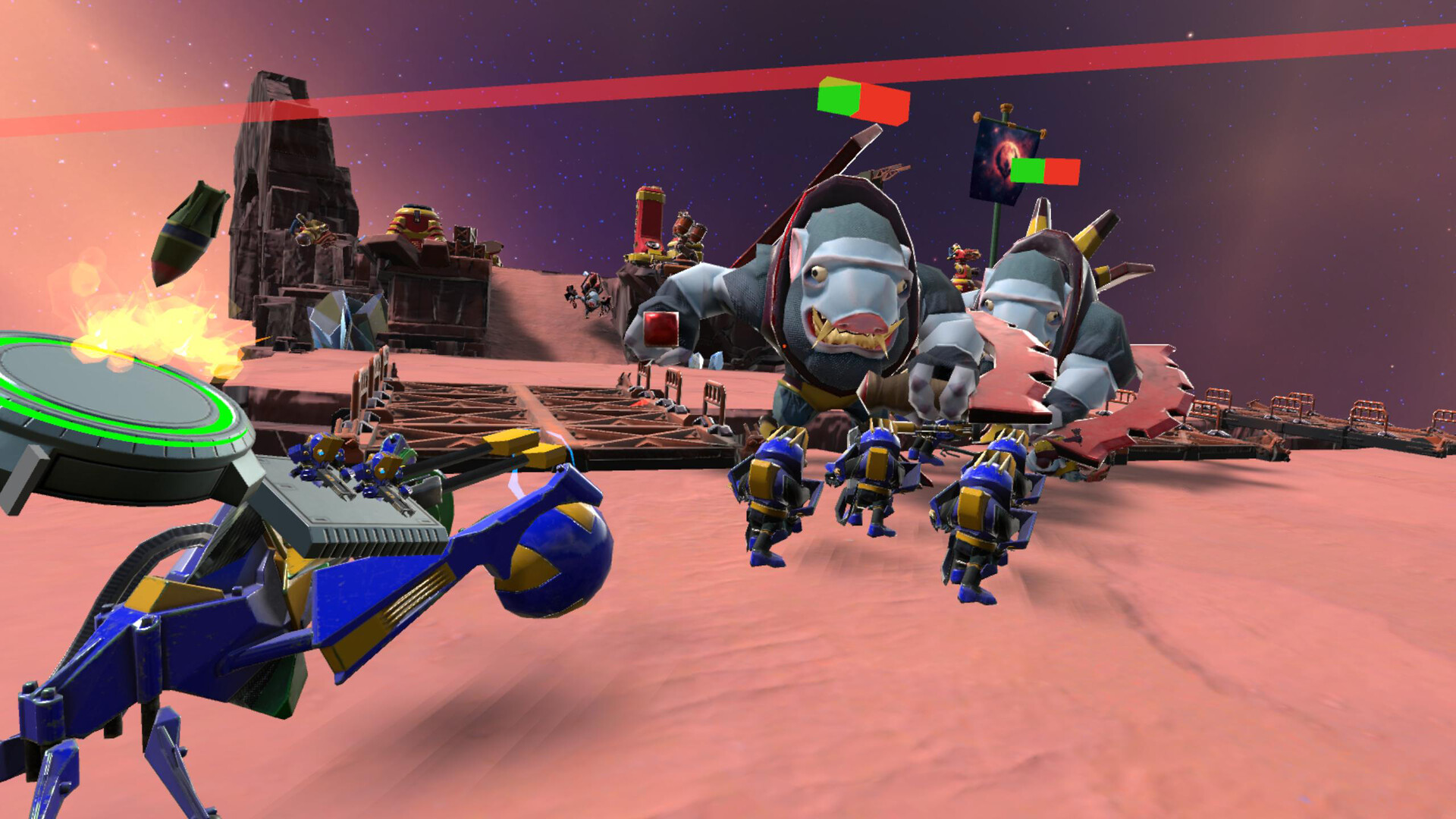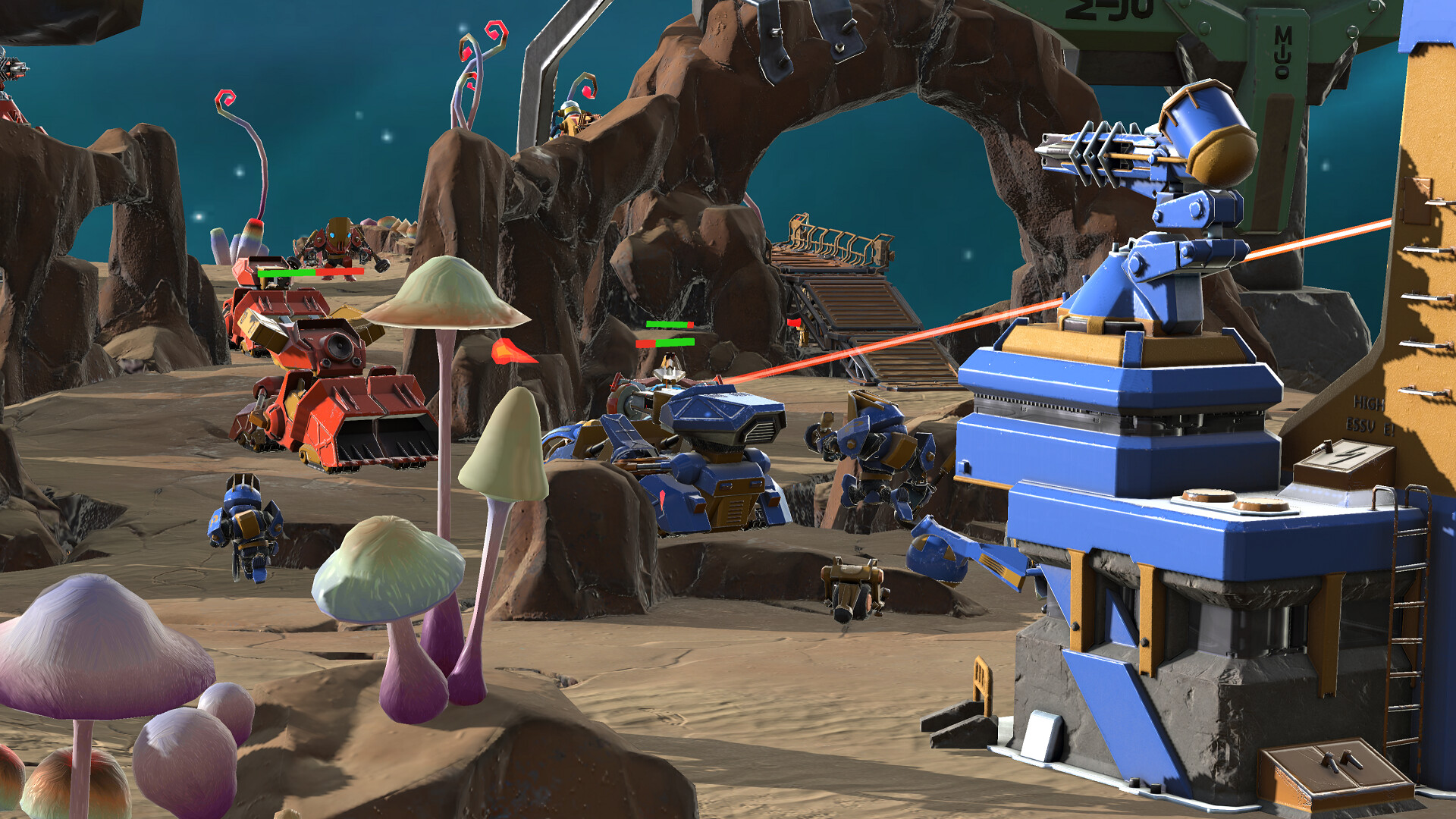
Expansion VR reinvents real‑time strategy for virtual reality by compressing matches into short, razor‑sharp duels where deck construction and split‑second choices decide the outcome. You curate a bespoke deck; swarmers for harassment, lumbering siege beasts for lane control, and nimble support specialists for clutch plays; and then physically summon and direct them with intuitive motion controls, turning each deployment into a deliberate tactical gesture.
The sci‑fi arenas are designed to reward timing, positioning, and counterplay: outmaneuver an opponent, exploit unit synergies, and tear down their Command Tower before yours falls. With a motion‑first interface, brisk match cadence, and clear strategic depth, Expansion feels both approachable for newcomers and endlessly replayable for competitive players.
Core Loop and Mechanics
At its core, Expansion VR fuses deck‑building depth with tactile, hands‑on unit deployment: you draft and refine a bespoke roster of units and abilities, then physically summon and position forces with intuitive gestures that feel like commanding a miniature army on your palm.
Matches hinge on timing, lane control, and clever counterplay; the right unit at the right second can flip momentum, and clear rock‑paper‑scissors relationships reward anticipation and reads rather than brute force.
The interface is purpose‑built for VR comfort; grab to shift the playfield, pinch to zoom, and natural hand rotations to sweep the map; so controls stay invisible while haptic feedback, crisp visual cues, and tight responsiveness make each placement and counterplay decision feel immediate and meaningful.

Modes and Campaign
Expansion VR began as a duel‑first experiment but has steadily matured into a fuller, more versatile package: quick PvP skirmishes, configurable AI opponents, and the newly launched Campaign Mode now offer multiple, distinct ways to play. The Campaign layers structured missions, mission‑specific objectives, and narrative briefings over the core deck‑building loop, drip‑feeding new units and mechanics that meaningfully expand tactical options as you progress.
A recent update added four striking new maps and a large‑scale default camera that open up fresh strategic vistas, while balance passes and smarter AI make single‑player encounters feel less predictable and more rewarding. Crucially, matches remain intentionally short, perfect for five‑minute pick‑up sessions; yet the game scales cleanly into longer, competitive stretches when you want to grind ladder play or experiment with deeper deck synergies.

Strengths
Expansion’s biggest strengths are its accessibility and polish: the motion‑based summoning feels tactile and rewarding, with crisp feedback that makes each deployment feel deliberate rather than fiddly; the visuals are clean and stylish without demanding top‑tier hardware, so the game runs smoothly across a wide range of rigs; and the brisk match cadence encourages learning by doing, letting players iterate quickly and internalize strategies through repetition.
The deck‑building layer adds meaningful depth, creating space for emergent synergies and clever counters rather than rote play, and the Campaign update demonstrates the developer’s willingness to broaden the experience; adding narrative context, new units, and mission variety that deepen long‑term engagement. Together, these elements make Expansion an inviting entry point for VR RTS newcomers while offering enough tactical nuance to keep competitive players coming back.

Weaknesses
Despite its promise, Expansion VR still feels thin compared with more mature VR RTS offerings. Maps are compact to the point that tactical maneuvering is often constrained, unit AI and behavioral depth can come across as rudimentary, and the game’s auto‑battler design removes much of the direct control players expect from a strategy title once units hit the field.
Matchmaking and online population are inconsistent, which makes finding competitive matches hit‑or‑miss, and a handful of technical issues; missing enemy spawns, intermittent connection hangs, and a surprising lack of graphics and quality‑of‑life options; undermine otherwise enjoyable sessions.
Add limited single‑player variety and sparse progression systems to the mix, and the result is a game that’s fun in short bursts but risks losing long‑term players; lingering community concerns about developer communication only amplify buyer caution until the roadmap and support cadence become clearer.

Final Verdict
Expansion VR is an inventive and approachable take on RTS in virtual reality; its motion‑first summoning, brisk match cadence, and deck‑building layer make for addictive, bite‑sized tactical duels that are easy to pick up and rewarding to master.
The recent Campaign update and steady polish show clear ambition and a developer willing to expand the game’s scope, and the visuals and performance make it accessible across a wide range of headsets.
That said, the experience still feels incomplete: compact maps, shallow unit AI, the auto‑battler limits on direct control, inconsistent matchmaking, and a handful of technical bugs keep Expansion from competing with deeper VR strategy staples. Community unease about developer communication adds a practical caveat for buyers.
If you want a lightweight, motion‑driven RTS to play quick, satisfying matches, or you’re eager to support an Early Access project with visible potential, Expansion is worth trying. If you need a fully featured, long‑term competitive RTS right now, it’s wise to watch the roadmap and updates before committing.
Watch and Wishlist
Watch for continued updates to matchmaking, AI behavior, and the developer’s communication cadence, those will determine whether Expansion grows into a competitive scene or remains a niche curiosity.
On the wishlist are larger maps and more unit pathing control to deepen tactics; richer deck synergies and randomized modifiers to keep matches fresh; robust matchmaking and spectator tools for competitive play; graphics and UI options for PCVR users; and quality‑of‑life fixes for spawn bugs and session stability.
A clearer roadmap and regular community engagement would go a long way toward restoring buyer confidence.
Key Takeaways and Score
• Accessible RTS in VR: Quick matches and motion controls make Expansion an easy entry point for VR strategy newcomers.
• Deck play matters: Unit unlocks and deck tuning reward experimentation and incremental mastery.
• Campaign adds value: The new single‑player campaign gives the game a narrative spine and more progression.
• Needs deeper systems: Small maps, limited unit control, and matchmaking gaps hold the game back from competing with top VR RTS titles.
Score: 7.0 / 10
Expansion VR is promising and often fun: it nails accessibility, looks good, and the Campaign shows ambition. Right now it’s best suited to players who want a lightweight, motion‑driven RTS or who want to support an Early Access project with clear potential. With larger maps, deeper unit control, and stronger community support, Expansion could become a standout; in its current state it’s an intriguing, imperfect experiment worth watching.